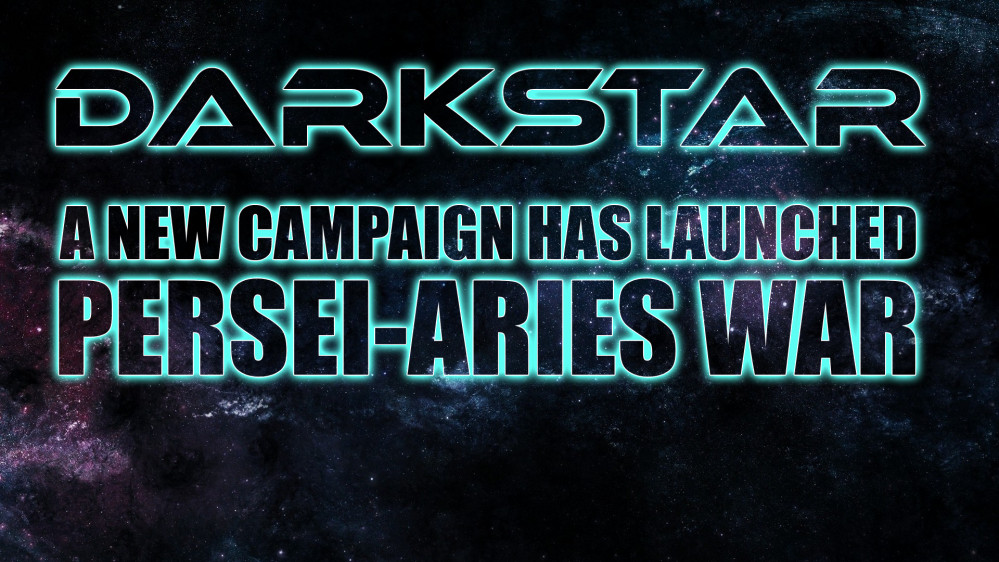
Persei-Aries War Resumes
SECOND BATTLE OF HAWKING'S STAR
FROM: UNITED NATIONS REGIONAL COLONIAL CENTER
13:10 SOL GMT, 06 APRIL 2521
BREAKAUTH: 181072.18J
CLEARANCE: SECRET (NATIONAL)
**UNITED NATIONS COMMUNIQUE**
Reports continue to come in from the spinward shoulder of the Hercules Rim, where another major battle has taken place in the Hawking’s Star (HR6806) planetary system. These British colonies have been the epicenter of intense naval action for over a month, ever since a spectacularly successful raid by a combined carrier-cruiser task force of the United States and the Holy Russian Empire all but shattered the Royal Navy in the system.
Commanded by Captain Zachary Irons aboard the Endeavor class light fleet carrier USS Liberty, this “raid” might’ve taken the Hawking’s Star system outright and ended the Third Hercules War in a single bloody afternoon. However, this strike had been planned and executed as a raid only, and neither the US or Russian navies had the planetary assault ships in position to capitalize on the success. In short, the degree of Task Force Liberty’s success in the First Battle of Hawking’s Star was as much a shock to the American and Russian commanders as it had been to the unfortunate British.
As it was, the closest US Marine assault ship was 13 light-years away at Alpha Lyra (Vega), while the closest Russian base capable of supporting any such “take and hold” invasion was well over twice that distance.
[Game Terms: When setting up a Darkstar game, players agree to assess victory points as either a RAID or an ASSAULT. A MAJOR VICTORY (+40% VP margin) in a game of sufficient size (at least 300+ points = “Large Engagement”) determines ownership of the star system. In our last game, Damon and I agreed to a 497-point RAID, which I was then fortunate enough to win by well over a 40% margin. Had this been an ASSAULT, the campaign rules would have given my Americans and Russians possession of the Hawking’s Star colonies. But since the game had been conducted as a RAID, with different victory point priorities driving different game strategies for myself and Damon as players, it wouldn’t be fair to have the Americans and Russians retroactively TAKE the system, despite the victory margin.]
However, once the extent of Task Force Liberty’s success became clear, US Naval Command at Alpha Lyra were quick to act. Immediate orders were dispatched to the Saipan-class planetary assault ships USS Belleau Wood and Iwo Jima, carrying 2nd and 3rd Battalions / 5th Marine Regiment. At a ninth-magnitude Darkstar Wave, they reached the Hawking’s Star system in 22 days. In that time, the USS Liberty had been pulled back to Vega, while the light carrier USS Tarawa was sent in her place along with the newly repaired San Antonio class light cruiser USS Spokane (Captain David Cheatham). Their Russian allies were also able to get a Kutusov class light carrier (CPK Gavrilov) to Hawking’s Star, determined to participate in what was hoped would be a war-winning victory.
Russo-American optimism was not unfounded. Things hadn’t gone well for the Royal Navy in the Third Hercules War, already there were calls for a change of government in the House of Commons or at the very least, an immediate end to British involvement in the war. Now, with the Belleau Wood and Iwo Jima carrying 2000 Marines, grav tanks, APCs, orbital assault boats, and “Avenger” ground attack bombers in the protoplanetary belt of Hawking’s Star, and a combined Russo-Amerian cruiser-carrier force again poised to strike to the heart of the system, it seemed as if British fortunes in the Hercules Rim were about to come to an abrupt end.
However, the British had also used the previous three weeks to maximum effect. While the heavy cruiser HMS Agamemnon and light cruiser Retribution would still be under repair at the nearby Outer Hebrides (Mu Hercules) system, the light fleet carrier HMS Vindictive and destroyer HMS Sheffield would be ready to re-sortie again into the core orbital zones of Hawking’s Star. More good news arrived in early April when the advanced Japanese heavy cruiser IJN Kama and strike frigate IJN Urakaze arrived from the Kyokko Bijin (Zeta Hercules) system. Together, this Anglo-Japanese force just might be able to stop the Russo-American task group determined to end the war (at least for the British) once and for all.
The question came to a head on 6 April, 2521 … when the two forces collided at Eastman’s Manor, outermost terrestrial planet in the Hawking’s Star core orbital zones.
Americans and Russians: Jim (Oriskany)
British: Damon
Japanese: Rasmus
339 points: ASSAULT
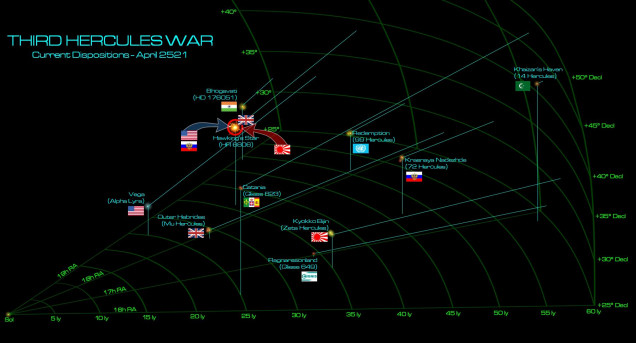 Here we see the current state of the Third Hercules War. Despite intermittent victories and draws, a series of Royal Navy defeats, first in the Krasnaya Nadhezda (72 Hercules) system, and later in their own Hawking’s Star colonies, have seriously compromised British interests in this region. Simply put, the CANNOT lose here, or their government will sue for peace on American, Russian, and Indian Republic terms.
Here we see the current state of the Third Hercules War. Despite intermittent victories and draws, a series of Royal Navy defeats, first in the Krasnaya Nadhezda (72 Hercules) system, and later in their own Hawking’s Star colonies, have seriously compromised British interests in this region. Simply put, the CANNOT lose here, or their government will sue for peace on American, Russian, and Indian Republic terms.  Here is the matchup for today’s game. The Hawking Beta, Gamma, and Delta stations are more or less there for “table dressing,” they have no effect outside of stacking limits in their hexes. However, the asteroids beside them (remains of a small moon that has been gradually broken up for mining) pose a significant navigational hazard. Either way, these stations are unarmed, cannot be attacked, and are not objectives. They’re just the kind of thing one sees in the HEART of a heavily colonized and industrialized system. In other words, no more skirmishing out in the Kuiper Belts, Oort Clouds, or outer gas giant moon systems. This in the heart of Hawking’s Star. This game is an assault, we’re playing for keeps. The Americans seen to be outmatched, outnumbered 4-3 in warships, 2-1 in aerospace, and with no heavy cruiser. However, the USS Salt Lake is the largest ship from Task Force Liberty, while the USMC aerospace strike carrier USS Tarawa is detached from none other than Task Force Oriskany itself. These ships are BEYOND upgraded.
Here is the matchup for today’s game. The Hawking Beta, Gamma, and Delta stations are more or less there for “table dressing,” they have no effect outside of stacking limits in their hexes. However, the asteroids beside them (remains of a small moon that has been gradually broken up for mining) pose a significant navigational hazard. Either way, these stations are unarmed, cannot be attacked, and are not objectives. They’re just the kind of thing one sees in the HEART of a heavily colonized and industrialized system. In other words, no more skirmishing out in the Kuiper Belts, Oort Clouds, or outer gas giant moon systems. This in the heart of Hawking’s Star. This game is an assault, we’re playing for keeps. The Americans seen to be outmatched, outnumbered 4-3 in warships, 2-1 in aerospace, and with no heavy cruiser. However, the USS Salt Lake is the largest ship from Task Force Liberty, while the USMC aerospace strike carrier USS Tarawa is detached from none other than Task Force Oriskany itself. These ships are BEYOND upgraded. 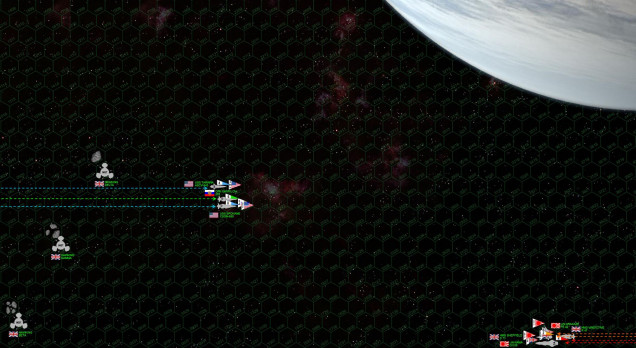 The actual map setup and initial approaches. The planet of Eastman’s Manor (roughly Mars-sized) looms at upper right. The Americans and Russians enter at a VERY high speed of 45 kilometers per second (hex = 180 kilometers, a turn is 1 minute), decelerating at full reverse thrusters, while the British and Japanese set a much more wary course at lower right, speeds at 18 and 15 KPS. Any ship that ends its movement within 10 hexes of the planet is subject to gravity.
The actual map setup and initial approaches. The planet of Eastman’s Manor (roughly Mars-sized) looms at upper right. The Americans and Russians enter at a VERY high speed of 45 kilometers per second (hex = 180 kilometers, a turn is 1 minute), decelerating at full reverse thrusters, while the British and Japanese set a much more wary course at lower right, speeds at 18 and 15 KPS. Any ship that ends its movement within 10 hexes of the planet is subject to gravity. 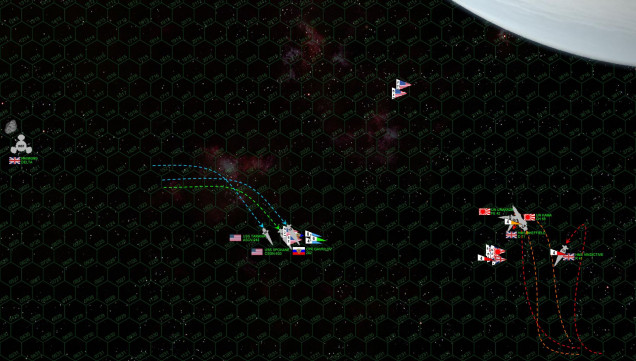 The British and Japanese cut hard to starboard, using the planet’s gravity for a little extra speed, setting up broadsides against the approaching invaders. The Americans and Russians (having largely won initiative) are happy to oblige, launching the rest of Tarawa’s Marine strike wing while setting up a broadside of their own, carefully ranged to make the best advantage of Spokane’s edge in gunnery accuracy. The Sheffield’s optronic gunnery systems and crews are just as sharp, however, while the Kama’s guns are also by far the biggest on the table. Range here is just under 2,000 kilometers, and damage on the Sheffield and Gavrilov are heavy. Meanwhile, HMS Vindictive completes the launch of her Starfire fighters and Nebula Typhoon bombers, the aerospace group staying close to the protective cover of the task force’s point-defense guns. The American Marines are being a little more aggressive, sweeping toward Eastman’s Manor and setting up for an imminent strike, combining with a large spread of Mark 48 and P-500 “Plamya” gravitic torpedoes launched from the American and Russian capital ships.
The British and Japanese cut hard to starboard, using the planet’s gravity for a little extra speed, setting up broadsides against the approaching invaders. The Americans and Russians (having largely won initiative) are happy to oblige, launching the rest of Tarawa’s Marine strike wing while setting up a broadside of their own, carefully ranged to make the best advantage of Spokane’s edge in gunnery accuracy. The Sheffield’s optronic gunnery systems and crews are just as sharp, however, while the Kama’s guns are also by far the biggest on the table. Range here is just under 2,000 kilometers, and damage on the Sheffield and Gavrilov are heavy. Meanwhile, HMS Vindictive completes the launch of her Starfire fighters and Nebula Typhoon bombers, the aerospace group staying close to the protective cover of the task force’s point-defense guns. The American Marines are being a little more aggressive, sweeping toward Eastman’s Manor and setting up for an imminent strike, combining with a large spread of Mark 48 and P-500 “Plamya” gravitic torpedoes launched from the American and Russian capital ships.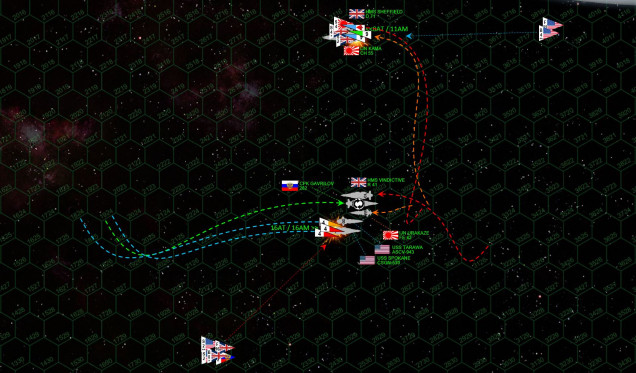 Turn 3, and the British and Russians make what I initially thought was something of a mistake here. As the Gavrilov lunges toward the Japanese (rolling on her back to protect her wounded port bow, the strike frigate Urakaze rushes right toward her as well, actually entering the same hex alongside the Russian light cruiser’s port side. That’s pretty much going to be it for the Urakaze, but if Rasmus can trade a frigate for a light cruiser, that’s not a bad move at all. However, the heavy cruiser Kama and destroyer Sheffield again turn hard to starboard, diving toward the planet, while the carrier Vindictive runs close abeam to the Urakaze. In effect, the Anglo-Japanese are divided in half, usually a VERY bad move when an American aerospace-torpedo strike is coming in. The Kama gets the worst of it, the Marines of VMF/A-319 “Tigershark” Squadron unleashing a hail of Harpoon torpedoes and Hellfire missiles, along with the Mk 48s and P-500s from the warships. But mass driver defense aboard the Kama and especially the valiant little Sheffield is ferocious, and while the Kama loses almost all the armor off her stern, her reactors and engines are almost undamaged by what SHOULD have been a killing strike. If Damon and Rasmus “made a mistake,” they got away with it. Meanwhile, the British strike against the American flagship USS Spokane, while textbook executed (concentrated on a single target, optimum range, no bombers lost to mass drivers, etc.) ... just doesn’t get the dice it needs. Even the missiles and torpedoes that DO hit the Spokane all hit in the “wrong” places, and while the American cruiser loses all her stern armor, no internal damage is inflicted at all. On both sides, the results of these heavy aerospace-torpedo attacks are bitterly disappointing. Guns open fire as well, with both the Gavrilov and Urakaze lost in a blinding, point-blank exchange. But Gavrilov is three times the size of the Urakaze, and at least for the moment, the British and Japanese are winning the day.
Turn 3, and the British and Russians make what I initially thought was something of a mistake here. As the Gavrilov lunges toward the Japanese (rolling on her back to protect her wounded port bow, the strike frigate Urakaze rushes right toward her as well, actually entering the same hex alongside the Russian light cruiser’s port side. That’s pretty much going to be it for the Urakaze, but if Rasmus can trade a frigate for a light cruiser, that’s not a bad move at all. However, the heavy cruiser Kama and destroyer Sheffield again turn hard to starboard, diving toward the planet, while the carrier Vindictive runs close abeam to the Urakaze. In effect, the Anglo-Japanese are divided in half, usually a VERY bad move when an American aerospace-torpedo strike is coming in. The Kama gets the worst of it, the Marines of VMF/A-319 “Tigershark” Squadron unleashing a hail of Harpoon torpedoes and Hellfire missiles, along with the Mk 48s and P-500s from the warships. But mass driver defense aboard the Kama and especially the valiant little Sheffield is ferocious, and while the Kama loses almost all the armor off her stern, her reactors and engines are almost undamaged by what SHOULD have been a killing strike. If Damon and Rasmus “made a mistake,” they got away with it. Meanwhile, the British strike against the American flagship USS Spokane, while textbook executed (concentrated on a single target, optimum range, no bombers lost to mass drivers, etc.) ... just doesn’t get the dice it needs. Even the missiles and torpedoes that DO hit the Spokane all hit in the “wrong” places, and while the American cruiser loses all her stern armor, no internal damage is inflicted at all. On both sides, the results of these heavy aerospace-torpedo attacks are bitterly disappointing. Guns open fire as well, with both the Gavrilov and Urakaze lost in a blinding, point-blank exchange. But Gavrilov is three times the size of the Urakaze, and at least for the moment, the British and Japanese are winning the day.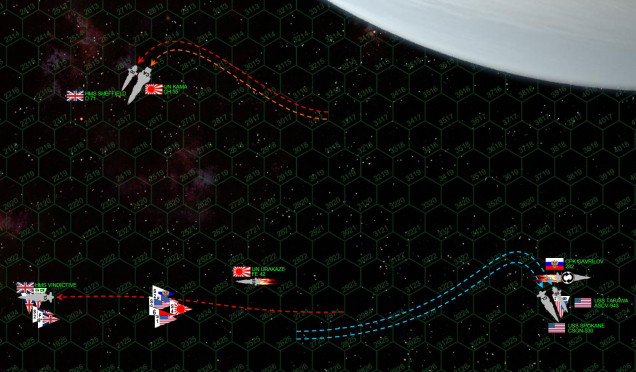 While the Urakaze and Gavrilov both spin out of control, burning and dead in space, the remaining ships of both sides streak past each other, engines on all ships pulling hard against Eastman’s Manor’s gravity as they begin to turn back toward each other. The Spokane actually side-slips to port slightly, then turning starboard to line up a long-range broadside on the stern of the carrier HMS Vindictive, which has slowed slightly to recover her bombers and some of her fighters, clearly to rearm for a second strike. Four Marine Grumman FS/A-81 “Avenger” torpedo bombers also land in the bays of the USS Tarawa. The Kama and the Sheffield have also set up long-range broadsides on the Tarawa, hoping to cripple the light carrier WHILE she’s rearming bombers. The enhanced gravitic shielding and electronic warfare suites of the Tarawa, however, along with the 3000+ kilometer range, spare the little Marine carrier the worst of enemy fire.
While the Urakaze and Gavrilov both spin out of control, burning and dead in space, the remaining ships of both sides streak past each other, engines on all ships pulling hard against Eastman’s Manor’s gravity as they begin to turn back toward each other. The Spokane actually side-slips to port slightly, then turning starboard to line up a long-range broadside on the stern of the carrier HMS Vindictive, which has slowed slightly to recover her bombers and some of her fighters, clearly to rearm for a second strike. Four Marine Grumman FS/A-81 “Avenger” torpedo bombers also land in the bays of the USS Tarawa. The Kama and the Sheffield have also set up long-range broadsides on the Tarawa, hoping to cripple the light carrier WHILE she’s rearming bombers. The enhanced gravitic shielding and electronic warfare suites of the Tarawa, however, along with the 3000+ kilometer range, spare the little Marine carrier the worst of enemy fire.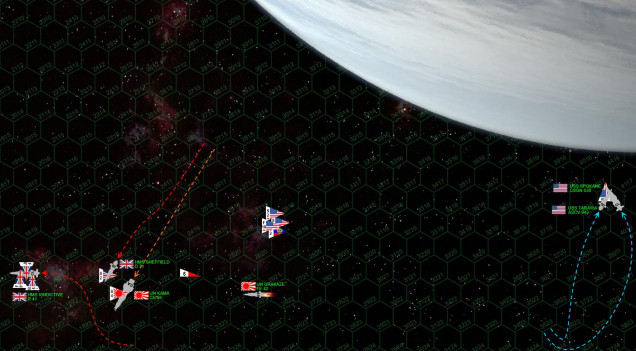 Recovery and rearming continue at a feverish pace aboard the Tarawa and the Vindictive, with Damon landing 8 more fighters even as 8 previous fighters and the initial 8 bombers complete rearmament in the Vindictive’s bays. Carriers of given classes are limited not only by how many aerospace craft they can carry, but how many they can launch and recover in a given turn. Especially with larger carriers, this can sometimes lead to tough “Nagumo-esque” decisions about when to recover, when to launch, and what ordinance packages to carry on a re-armed aerospace strike. The Sheffield takes more hits, some of which carve deep into the ship’s interior, causing heavy crew casualties and decompressions ... compelling her skipper to break off from the engagement. The Americans have plenty of their own problems, however. Seemingly minor hits on maneuvering thrusters aboard both USS Spokane and Tarawa mean they have a very hard time turning, rolling, and decelerating as they wish, especially while trying to screen badly-damaged sections of their hulls from further Japanese EPCs AND turning against planetary gravity. Captain Cheatham is forced to turn TOWARD the planet at a hair-raising distance, just praying he doesn’t take another hard hit and loses power until he can complete his turn ...
Recovery and rearming continue at a feverish pace aboard the Tarawa and the Vindictive, with Damon landing 8 more fighters even as 8 previous fighters and the initial 8 bombers complete rearmament in the Vindictive’s bays. Carriers of given classes are limited not only by how many aerospace craft they can carry, but how many they can launch and recover in a given turn. Especially with larger carriers, this can sometimes lead to tough “Nagumo-esque” decisions about when to recover, when to launch, and what ordinance packages to carry on a re-armed aerospace strike. The Sheffield takes more hits, some of which carve deep into the ship’s interior, causing heavy crew casualties and decompressions ... compelling her skipper to break off from the engagement. The Americans have plenty of their own problems, however. Seemingly minor hits on maneuvering thrusters aboard both USS Spokane and Tarawa mean they have a very hard time turning, rolling, and decelerating as they wish, especially while trying to screen badly-damaged sections of their hulls from further Japanese EPCs AND turning against planetary gravity. Captain Cheatham is forced to turn TOWARD the planet at a hair-raising distance, just praying he doesn’t take another hard hit and loses power until he can complete his turn ... 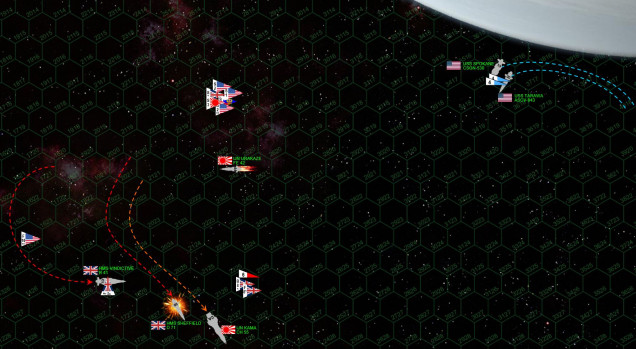 The Americans get away with it, completing their turn (their hulls perhaps glowing a little red) and pulling back out of Eastman’s Manor’s gravity. Presenting bows to the enemy, they can thus launch full frontal spread of torpedoes (what torpedoes they have left, that is, USS Spokane has actually lost her portside array). More immediately, the forward EPCs and 8 MgKv lasers of the Spokane still through the wounded side of HMS Sheffield, and at last the valiant little destroyer loses power. Burning and out of control, she careens out of the battle area. The Kama replies with her own broadside of vengeance, massive 18-teravolt EPCs burning away the Tarawa’s fo’c’sle and crippling forward shields. This is going to have a critical effect in the time to come. Meanwhile, the Marines get perhaps a little too aggressive, their F/S-44 Star Corsair fighters trying a strafing run against the stern of the Vindictive while their four Avenger bombers are swarmed by British and Japanese scouts which manage to shoot down two of them BEFORE they can launch more Harpoon aerospace torpedoes against the Vindictive.
The Americans get away with it, completing their turn (their hulls perhaps glowing a little red) and pulling back out of Eastman’s Manor’s gravity. Presenting bows to the enemy, they can thus launch full frontal spread of torpedoes (what torpedoes they have left, that is, USS Spokane has actually lost her portside array). More immediately, the forward EPCs and 8 MgKv lasers of the Spokane still through the wounded side of HMS Sheffield, and at last the valiant little destroyer loses power. Burning and out of control, she careens out of the battle area. The Kama replies with her own broadside of vengeance, massive 18-teravolt EPCs burning away the Tarawa’s fo’c’sle and crippling forward shields. This is going to have a critical effect in the time to come. Meanwhile, the Marines get perhaps a little too aggressive, their F/S-44 Star Corsair fighters trying a strafing run against the stern of the Vindictive while their four Avenger bombers are swarmed by British and Japanese scouts which manage to shoot down two of them BEFORE they can launch more Harpoon aerospace torpedoes against the Vindictive. 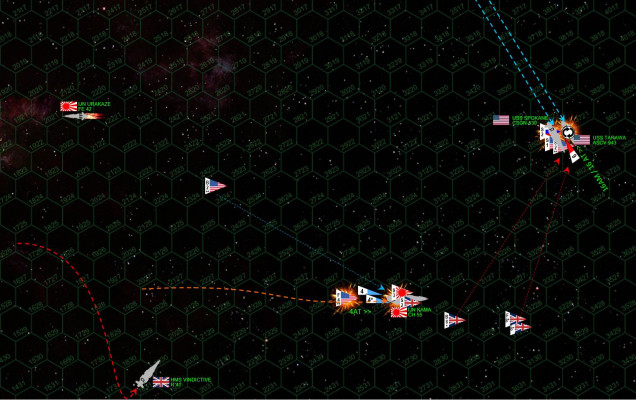 The Second Battle of Hawking’s Star takes a final horrific turn on Turn 7, where American torpedoes, bombers, and fighters on a gunnery strafing run rush the stern of the gigantic Japanese heavy cruiser IJN Kama. The Kama decides to mass her point-defense against the Marine fighters rather than the incoming torpedoes, hoping her shields will project her. It’s a fateful decision, especially for the Corsair pilots of VMF/A-319, which lose 60% of their strength in a hurricane of Japanese anti-aerospace fire. That means the torpedoes and missiles have a clear path, however, and the accuracy of these weapons (guided by elite Marine pilots, upgraded CiC of the USS Spokane, and enhanced electronic warfare aboard USS Tarawa) mean that the stern of the Kama is positively torn apart in the fusillade. Recall that Kama’s stern armor was largely shorn away in the previous aerospace strike, and the mighty heavy cruiser doesn’t survive a second encounter. Successive Mk 48s and Marine torpedoes explode INSIDE Kama’s engineering section, and the captain has to eject reactors to keep the ship from exploding altogether. Just that fast, the Americans have gone from losing this battle to being the clear victors. But the Japanese are not alone in their agony. Without shields over her bow, the USS Tarawa is targeted by the expert torpedo and missile strike of the Supermarine Starfire fighters and Nebula Star Typhoon bombers of HMS Vindictive, having relaunched her aerospace group and carefully protected them until they could get within range for a united second strike. The Tarawa soon takes missiles through the bridge, crippling the Marine carrier and sending it spiraling out of control from the battle zone. The rest of the strike goes for the Spokane, and together with the last volley from Kama’s forward guns, hits the forward magazine of the Spokane. The ship isn’t crippled, but that internal explosion causes enough decompression where Captain Cheatham is forced to break off the engagement.
The Second Battle of Hawking’s Star takes a final horrific turn on Turn 7, where American torpedoes, bombers, and fighters on a gunnery strafing run rush the stern of the gigantic Japanese heavy cruiser IJN Kama. The Kama decides to mass her point-defense against the Marine fighters rather than the incoming torpedoes, hoping her shields will project her. It’s a fateful decision, especially for the Corsair pilots of VMF/A-319, which lose 60% of their strength in a hurricane of Japanese anti-aerospace fire. That means the torpedoes and missiles have a clear path, however, and the accuracy of these weapons (guided by elite Marine pilots, upgraded CiC of the USS Spokane, and enhanced electronic warfare aboard USS Tarawa) mean that the stern of the Kama is positively torn apart in the fusillade. Recall that Kama’s stern armor was largely shorn away in the previous aerospace strike, and the mighty heavy cruiser doesn’t survive a second encounter. Successive Mk 48s and Marine torpedoes explode INSIDE Kama’s engineering section, and the captain has to eject reactors to keep the ship from exploding altogether. Just that fast, the Americans have gone from losing this battle to being the clear victors. But the Japanese are not alone in their agony. Without shields over her bow, the USS Tarawa is targeted by the expert torpedo and missile strike of the Supermarine Starfire fighters and Nebula Star Typhoon bombers of HMS Vindictive, having relaunched her aerospace group and carefully protected them until they could get within range for a united second strike. The Tarawa soon takes missiles through the bridge, crippling the Marine carrier and sending it spiraling out of control from the battle zone. The rest of the strike goes for the Spokane, and together with the last volley from Kama’s forward guns, hits the forward magazine of the Spokane. The ship isn’t crippled, but that internal explosion causes enough decompression where Captain Cheatham is forced to break off the engagement.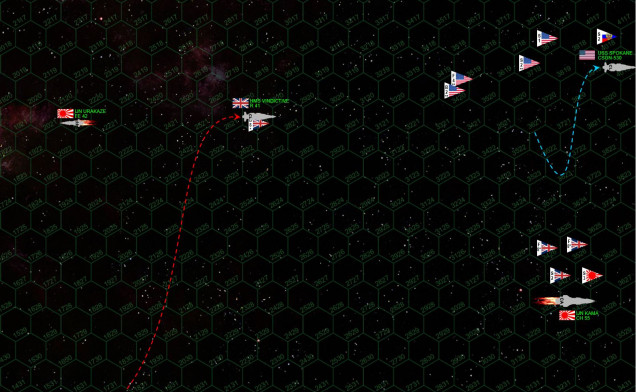 Turn 8, and we see the USS Spokane turn away from the last enemy ship, HMS Vindictive. Obeying the rules for breaking off, the Spokane is just able to remain on the table until the end of Turn 8 (the end of any ASSAULT game, Darkstar Rule 5.2.1., p. 92), meaning she counts as half victory points as a technically “operational” ship (Darkstar Rule 5.2.1.A.). As an ASSAULT game, this battle’s outcome is assessed based on what forces both sides have left on the table (again, Spokane only counts for half because she is being forced off the board). Carefully counting everything up, we come up with a shocking result. Counting every last scout plane, the Americans have 111 points on the table. The British and Japanese have ... 112. Rasmus and Damon have a +1 point victory margin, but the game goes down as a draw (Darkstar Rule 5.2.1.C.i). You have to win by at least 5% of the game’s beginning point value. Otherwise, High Command has determined this engagement “too close to call.”
Turn 8, and we see the USS Spokane turn away from the last enemy ship, HMS Vindictive. Obeying the rules for breaking off, the Spokane is just able to remain on the table until the end of Turn 8 (the end of any ASSAULT game, Darkstar Rule 5.2.1., p. 92), meaning she counts as half victory points as a technically “operational” ship (Darkstar Rule 5.2.1.A.). As an ASSAULT game, this battle’s outcome is assessed based on what forces both sides have left on the table (again, Spokane only counts for half because she is being forced off the board). Carefully counting everything up, we come up with a shocking result. Counting every last scout plane, the Americans have 111 points on the table. The British and Japanese have ... 112. Rasmus and Damon have a +1 point victory margin, but the game goes down as a draw (Darkstar Rule 5.2.1.C.i). You have to win by at least 5% of the game’s beginning point value. Otherwise, High Command has determined this engagement “too close to call.” So what does this mean? Well, the Second Battle of Hawking’s Star has gone down as a charred, smoking, blood-soaked draw. The two American planetary assault ships in the system’s outer debris belts are NOT called in (the British and Japanese have held on ... the core orbital zones of the system are NOT secured) ... but they’re not sent home to Alpha Lyra, either. The threat remains in place. The fate of Hawking’s Star, and the British in the Hercules Rim, and the Third Hercules War overall, remains in a razor-thin balance. In the chart above, we see where the results of this battle are all chalked up as “zero,” meaning the British still hover on the precipice of defeat. They have a -10 campaign score balanced against a “political commitment threshold” of 10 ... one more defeat point and they exceed that threshold ... their government sues for peace. The Americans and Russians, both at +3, are still technically “winning” this war, but the results of Second Hawking’s Star are nevertheless far from what they wanted. I’m sure we’ll keep this campaign going and see how it turns out. Stay tuned!
So what does this mean? Well, the Second Battle of Hawking’s Star has gone down as a charred, smoking, blood-soaked draw. The two American planetary assault ships in the system’s outer debris belts are NOT called in (the British and Japanese have held on ... the core orbital zones of the system are NOT secured) ... but they’re not sent home to Alpha Lyra, either. The threat remains in place. The fate of Hawking’s Star, and the British in the Hercules Rim, and the Third Hercules War overall, remains in a razor-thin balance. In the chart above, we see where the results of this battle are all chalked up as “zero,” meaning the British still hover on the precipice of defeat. They have a -10 campaign score balanced against a “political commitment threshold” of 10 ... one more defeat point and they exceed that threshold ... their government sues for peace. The Americans and Russians, both at +3, are still technically “winning” this war, but the results of Second Hawking’s Star are nevertheless far from what they wanted. I’m sure we’ll keep this campaign going and see how it turns out. Stay tuned! 









































































I don’t seem to remember “Gavrilov” in the Russian, Cruiser – I made a mistake going for the fighter, trying to get a few points, costing Kama
@rasmus – Gavrilov “in” the Russian cruiser? Gavrilov was the *name* of the cruiser – CPK (Holy Russian Ship) Gavrilov, Kutusov class light cruiser. The decision with the fighters indeed didn’t work out. That decision isn’t always a bad one, though. Had Kama’s stern armor been in better shape, she could’ve weathered that torpedo strike. Also, I got a pretty sweet roll on that if I recall. Third, that move is usually better when there are other ships to screen vs. torpedoes, etc … allowing your main ship to go for enemy aerospace craft, ESPECIALLY when they are elite or… Read more »
I can only say it was late – so I read it as the Russian captain
No risk no gain – take a chance pay the price
This was a good one.
It was in the balance right to the end.
Was quite pleased with myself that I managed to coordinate 2 airstrikes in an 8 turn game, shame the first one was such a damp squib…
Indeed, @damon , carrier ops in Darkstar take some getting used to. The carriers and their aerospace groups are vulnerable, complex, and high-maintenance. But I think you’re getting the hang of them. That first big strike SHOULD have been more effective. I rolled double sixes on those two big mass driver checks, both ships have upgraded CICs, one has upgraded electronic warfare, and then the missiles landed all over the hull. Fortunately for for the British, that second strike was far more effective, taking out the Tarawa and helping the Kama drive off the Spokane. Thanks for the comments and… Read more »
Looking good, as always love the write ups and the cinematic battles. Interesting gambles taken. Looking forward to seeing more.
Glad you like them, @muakhah . The write-up for your battle is now up as well! 😀